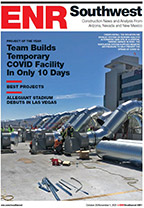Although tunneling distances are not great, the contractor has deployed 10 TBMs "as the only way to de-link the station construction from the tunnel drives and produce a realistic … construction program," explains Klados.
Herrenknecht is supplying six of the 6.6-m-dia VDTBMs and two EPBs. The company made the first VDTBM substantially in Germany and the rest in its Chinese facilities, says Klados. The remaining two EPBs came from the Zhengzhou plant of China Railway Tunnelling Equipment Co. Ltd.
Tunneling started late last May; the first Chinese EPB broke through on Dec. 24, followed shortly by the second. The first two VDTBMs have since completed their 1.2-km-long twin drives and the remaining four are still in play. Herrenknecht's two EPBs have yet to start.
With TBMs advancing at, on average, 70 m a week and tunneling nearly half done, the project team seems pleased with the technology. For karstic limestone, the variable-density machine is the "TBM of choice," Parks says.
The system "increases the envelope where TBMs can be used without major ground-treatment works prior to tunnelling," adds Klados, who anticipates the project's final breakthrough in mid-2015.




Post a comment to this article
Report Abusive Comment